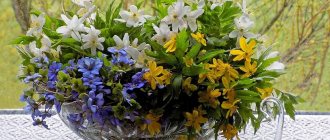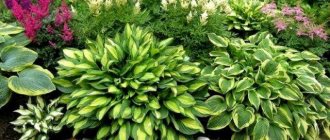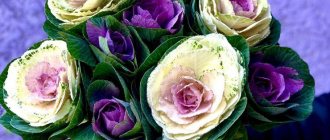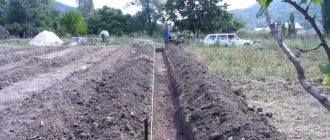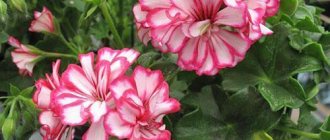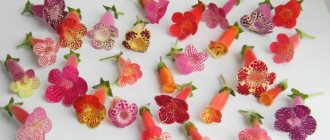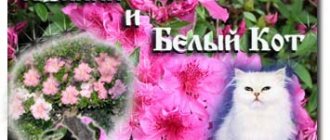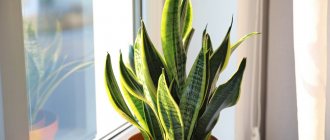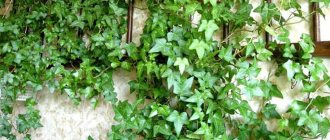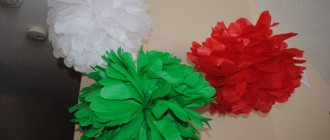The Russian and Belarusian names of ivy-shaped budra play off the similarity of the herbaceous plant with both peppermint and ivy, which quickly spreads across the ground. In nature, this grass from the Lamiaceae family creates dark green, curly lawns. In our review, let's look at the description, properties and use of ivy budra, and learn how to grow it in the open ground and in the house.
Catnip, catnip, ivy, dogmint, glechoma, moleflower, magpie - these are all names of one perennial that has medicinal properties. Since the culture is poisonous, we will look at the contraindications and precautions in this article.
Botanical description
Where does catnip grow? You can find the plant everywhere! Both in nature on the edges and clearings, in the shade under bushes and in swamps, and as a weed in a summer cottage or garden plot.
Table 1.1 - Description of the plant
| Grass parts | Peculiarities |
| Height of creeping and erect shoots | Depending on the type of shoots, from 10 to 40 cm. The stem may be covered with small hairs or fluff. |
| Leaves | Embossed leaves on long petioles are located oppositely on the shoot. The shape of the pubescent leaf is heart-shaped, the edges are carved and jagged. They have a very faint mint aroma. |
| Flowers | Two-lipped flowers are located in the leaf axils of 3-4 pieces, the color of the petals is bluish-lilac, white or deep purple. |
| Fruit | After flowering, a fruit is formed (its length is 2 mm), breaking into 4 parts. |
Information! In the photo and description of ivy bud, you can see the division of shoots into vegetative and flowering. Vegetative stems creep along the ground, taking root at the first opportunity into the ground. And flowering shoots are only erect.
If a shoot or leaf is damaged, the plant emits a specific odor similar to the “aroma” of cat urine. Perhaps the name catnip was given because of this feature of the herb.
The heart-shaped leaves retain their green color even in winter, so experts classify catnip as an ornamental crop.
Flowering of ivy bud begins in May, lasting until mid-August.
The tissues of the above-ground part of the plant contain:
- saponins and bitterness;
- vitamin C, minerals (titanium, potassium, manganese);
- aldehydes, choline;
- triterpinoids, alkaloids;
- acids: tartaric and acetic;
- cysteine, methionine, carotene;
- essential oils.
Budra ivy: for oncology and migraine
Budra ivy (creeping) is a poisonous herbaceous perennial of the Lamiaceae (Lamiaceae) family.
Has the following popular nicknames:
- dognip;
- catnip (although this is more often called catnip, another species of this family);
- blue;
- rams.
Description
The stems are creeping, from 15 to 50 cm, sometimes slightly pubescent, often glabrous. Ivy bud is named because its leaves resemble ivy leaves: they look like hearts with zigzag edges. Small gramophone flowers of blue, blue, violet shades: the middle is darker. The lower lip of this two-lipped flower is longer than the upper. Blooms from April to June. A characteristic feature of the plant is a strong smell reminiscent of mint. People perceive this smell as unpleasant, although budra is used to flavor drinks and is added to broths for flavor. Dognip stays green for a very long time, even until snow falls. In spring, when the snow melts, these leaves turn purple.
Livestock does not eat budra, but bees love this plant, and honey from budra is very healthy. This moisture-loving plant grows in meadows and forests of the European part of Russia, the Caucasus, and Siberia. Ivy budra was considered a talisman. She was dropped off at the house to protect the family from the evil eye and disease.
Budra ivy bushes photo
Compound
The herbaceous part contains a rich set of active components:
- bitterness;
- choline;
- gum;
- methionine (amino acid);
- steroids;
- alkaloids;
- tannins;
- flavonoids;
- essential oil.
Medicinal properties
In Russia, the plant does not have medicinal status, although in Germany and France it is used by official medicine. Among the people, budra is sometimes called the “forty-day medicine,” that is, a cure for 40 ailments.
Budra is shown:
- for oncology;
- burns;
- disruption of the thyroid gland (diffuse goiter);
- benign tumors;
- ENT diseases;
- diseases of the urinary system;
- gastrointestinal diseases;
- against helminths;
- as an external remedy – for rashes, boils, psoriasis;
- as a gargle – for inflammation of the throat and mouth.
Laboratory studies have confirmed the effectiveness of budra in the fight against cancer: it suppresses the growth of cancer cells and the formation of metastases. Budra is used in official pharmaceuticals as a fragrance for medicines.
Budra ivy flowers photo
Medicinal use
To prepare potions, the above-ground part of the bud, harvested during flowering, is used. The tender upper part of the plant is cut off with scissors and dried at room temperature. Dry raw materials are bitter and burn. It should be stored in paper bags, glass or tin jars for no more than a year.
Recipes
There are a huge number of folk medicine recipes with dog mint. Here are just a few of them:
Budra infusion:
1 tsp raw materials, pour 250 ml of hot water, leave for an hour under the lid.
For coughs, acute respiratory infections, chronic sinusitis, kidney stones, gout, take a quarter glass three times a day, half an hour before meals. For cholecystitis, the course of treatment is 3 weeks, drink a third of a glass three times a day.
The infusion is effective externally as an eye lotion for conjunctivitis, as a compress for a fracture (accelerates bone regeneration). Douching with infusion is used for leucorrhoea and gonorrhea (twice a day). The infusion is used to gargle an inflamed throat and mouth when the gums are inflamed.
Budra juice against liver cancer
bronchi, throat, lungs and liver cirrhosis, take 10-15 drops three times a day 30 minutes before meals. To preserve it, add 25 ml of alcohol for every 100 ml of juice and store it in a glass bottle in the refrigerator.
Against liver cancer: 10 drops of budra juice preserved in alcohol are added to the budra infusion according to the standard recipe. Take a third of a glass three times a day 30 minutes before meals.
It is interesting to use bud juice for migraines:
3 drops of juice are instilled into each nostril. This is an excellent option when a migraine is accompanied by vomiting and it is not possible to swallow a painkiller tablet.
Bath for gout:
pour 4 tbsp into a liter of boiling water. raw materials, cook for 15 minutes. Add 1 liter of water and
take a bath until it cools down.
Contraindications
Since budra terrestris is highly toxic, an overdose causes flu-like illness.
condition, severe salivation, irregular heartbeat. It is contraindicated for pregnant and lactating women, with hypertension and increased blood clotting, severe liver damage, gastritis with low acidity.
Popular variety in landscape design
Many summer residents, having discovered catnip on their property, try to remove it. But a variety of glechoma has been developed, which is highly decorative and fast growing. During the season, you can create a beautiful living carpet on your site if you plant ivy-shaped budra Variegata.
Features of Variegata:
- The leaves are decorated with specks, iridescent silver;
- The length of creeping shoots is 30-70 cm and the height of flower stems is 10-15 cm;
- Flowering begins in May, in the fall the leaves turn pinkish-green and so go into winter;
- To preserve its decorative appearance, it needs to be illuminated by the rays of the sun for 3-4 hours. In partial shade, the foliage becomes pale green and silvery inclusions are almost invisible.
Planted in hanging pots and used as a ground cover crop.
What, you don’t know each other?! - Well, meet me!
Budra ivy is a perennial creeping herb of the Lamiaceae family, about 10-15 (sometimes up to 50) cm high. The specific epithet ivy refers not so much to the leaves of the budra, but to the nature of its growth. In favorable conditions, it completely covers the foot of the forest, hiding small dead wood and even fallen trunks under its cover. Almost the same, but even larger-scale picture in Colchis is formed by ivy.
In the center of the European part of Russia, budra is literally omnipresent. It can be found on school grounds in the very center of the city, in a city park, on the bank of a stream, in a floodplain forest, in an open field, and even on overgrown arable land. This is one of those grasses that man has not displaced even from extremely paved megacities.
Budra does not tolerate dryness, but does not tolerate constant waterlogging. It cannot be found at all on dry lands with sandy loam soils. But if the soil is fertile and constantly moist, the budra grows like a continuous carpet.
Healing properties of catnip
The perennial herb contains a huge amount of substances, including valuable essential oils, which generally have a positive effect on the human body.
The use of dognip for medicinal purposes is due to the ability of the components found in the tissues of the plant to remove toxins from our body. Lungs, kidneys, liver and gastrointestinal organs are involved in excretion. And since catnip supports the functioning of the pulmonary system and pancreas, it becomes an “assistant” in cleansing the body.
The collection of leaves, stems and flowers is carried out during flowering; the roots of the grass are not used.
Let's look at the medicinal properties of dried leaves and flowers of budra ivy, as well as their use in more detail.
Use in homeopathy and traditional medicine
- The active substances that are found in catnip have choleretic, antiviral, diuretic, choleretic, antibacterial, hemostatic properties;
- The herb is used as an antiseptic for inflammation, for healing wounds, burns, frostbite;
- Remedies from ivy bud improve the functioning of the digestive organs, relieve pain in the stomach, diseases of the spleen and liver;
- The herb helps remove sand from the bladder, strengthens the vascular system, normalizes blood pressure (but not during a hypertensive crisis!);
- Accelerates metabolic processes in the body thanks to zinc, normalizing the functioning of the thyroid, pancreas and prostate glands;
- It is used as an expectorant for diseases of the respiratory system, for which the plant was called “chest grass”;
- For the treatment of ulcers and wounds, for lacrimation, conjunctivitis, an infusion of the plant is used as an external remedy;
- The decoction relieves toothache. It is also useful for the treatment of periodontal disease, stomatitis and sore throat. Use the broth only for rinsing!
Where the medicinal properties of ivy bud are used, see photo:
As a healing agent for fractures (apply a bandage). Fresh leaves (1-2 pieces) are added to salads as a spice; they improve microflora and digestion:
Dognip essential oil is used for disinfection, to flavor drinks, and also to mask the unpleasant odor of medications. Enough to use 1-2 drops:
To treat skin diseases and reduce pain from abscesses, fresh leaves are used, which are crushed. To obtain a paste, add boiling water. Used as compresses:
Infusions of leaves and flowers are used to make baths, lotions, and washes for tumors, dermatoses, scrofula, and gout. Medicinal herbs are often included in herbal preparations that are sold in pharmacies. You can also buy dry ivy budra separately.
Watch a video about the properties and use of weeds that we are trying to remove from our plots. Also, will you find out if it is poisonous or not?
Attention! The plant is poisonous, so be extremely careful when using it.
Budra ivy - hanging plant
Budra ivy belongs to the Lamiaceae family. This name comes from Ancient Greece, where it meant “mint of the field.” The plant has a creeping root system. The length of the tetrahedral stem with numerous shoots varies from approximately 20 to 50 cm. The branches on the stem are directed upward. The leaves are evergreen, heart-shaped with short pubescence, like the stem.
Budra ivy in the wild
This culture is blooming. Its flowers have a lilac or blue tint, they are small and funnel-shaped. The corolla grows up to 2 cm. Flowering begins in May or early June and continues until the end of July. The fruit, in the form of a four-part nut, ripens in August and reaches 2 mm. Young shoots are replaced with old ones 2 times a year: before flowering and after
Interesting! The smell of the herb is close to mint, but it is not as pleasant.
Ivy bud is a honey plant. The resulting nectar has a light amber color, a pleasant aroma and beneficial properties.
Reproduction occurs by seeds or vegetatively, as well as by cuttings for planting at home. The budra cuttings are planted in a pot, cache-pot, flowerpot or basket using garden soil. Such a houseplant is called ampelous budra.
In order to get rid of the plant, mowing or chemical spraying is used.
Medicinal properties
Ivy budha has healing properties:
- anti-inflammatory;
- expectorant;
- antiseptic;
- choleretic;
- antibacterial;
- antipyretic.
The stem of the Budra flower
improves the functioning of the gastrointestinal tract, helps with diarrhea, gastritis, liver, kidney and spleen diseases. Removes salts from the body and speeds up metabolism. Decoctions and infusions of budra have a beneficial effect on the lungs and throat, treat laryngitis, tuberculosis, bronchitis and many other diseases of the upper respiratory tract. It is used as a lotion and compress on wounds, burns, tumors, and budra juice is used for toothaches and stomatitis.
It has been proven that the stem and leaves contain:
- essential oil;
- ascorbic acid;
- aldehydes;
- carotene;
- saponins;
- flavonoids;
- choline;
- methionine;
- resins;
- iron;
- bitterness;
- zinc.
Note! Budra ivy is a poisonous plant, so there are contraindications for its use. The herb is used only with a doctor’s prescription in prescribed doses.
It is necessary to take breaks between courses. The herb should not be used by pregnant and lactating women, as well as children. Due to the content of toxic substances, budra is highly not recommended to be fed to pets and livestock.
The herb is used only with a doctor's prescription in prescribed doses. It is necessary to take breaks between courses. The herb should not be used by pregnant and lactating women, as well as children. Due to the content of toxic substances, budra is highly not recommended to be fed to pets and livestock.
There is an opinion that the plant has magical properties. It is even called “witch’s grass,” which supposedly reveals unusual and energetic abilities in a person.
Side effects and contraindications
Budra is a very useful herb with healing qualities. But any plant cannot be taken without measure and without consulting a doctor when treating diseases. In addition to the medicinal properties, ivy budra also has contraindications, since the plant is a poisonous crop.
Should consult a doctor before use:
- nursing mothers and pregnant women;
- those suffering from chronic pathologies of the liver and kidneys;
- patients with reduced acidity of gastric juice;
- and with increased blood clotting.
Use with caution at high blood pressure. The regimen and dosage must not be violated! If taken in large quantities, the plant will cause poisoning.
Symptoms that the body has been poisoned with budra:
- increased body temperature;
- slow pulse;
- rapid breathing;
- increased salivation;
- bleeding.
You should immediately take activated carbon or calcium chloride and call an ambulance.
Toxic properties of the plant
Dognip contains an essential oil that is physiologically active in moderate to large quantities. This oil is believed to be responsible for the toxicity of the plant. In addition, although in small quantities, the natural toxic substance pulegone is present here.
In several European countries, the weeds were often considered poisonous to horses. Symptoms of toxicity include sweating, salivation, difficulty breathing, dilated pupils, and sometimes signs of pulmonary edema.
Apparently, ivy bud is toxic only if it is consumed in large quantities fresh or in hay (horses are the ones that are affected).
People using dognip or planning to use it for therapeutic purposes should exercise great caution.
Pregnant women should not use this herb or formulations made with it because it has abortogenic (causes miscarriage) properties.
The use of budra is also prohibited for patients with epilepsy. Large doses can irritate the stomach, intestines and kidneys, and cause serious liver damage.
People with a known allergy or hypersensitivity to blueweed or other members of the Lamiaceae family, including mint, rosemary, basil, oregano, thyme, and lavender, should avoid using it for therapeutic purposes.
Budra essential oil should absolutely not be taken internally; it is only for topical use on the skin.
Growing a flower or weed
On their plots, gardeners grow ornamental varieties in hanging pots or as ground cover plants. The variegated variety Variegata is popular among Russian flower growers. It blooms from May to August, but there are few flowers compared to ivy bud. All the decoration is in the leaves with white or silver splashes.
Another variety stands out for its spectacular heart-shaped leaves - Golden October, which can be found with ivy budra in the Plantarium (plant identification atlas). The foliage of this variety is dark green. The surface of each leaf is covered with small golden spots. When the heat subsides in August, the color of these spots is especially rich.
All varieties of budra are unpretentious to growing conditions.
It is only important to ensure:
- sufficient amount of sunlight in the flower bed;
- The flower is unpretentious to the composition of the soil, but for cultivation it is better to plant it in slightly acidic, slightly alkaline soil or with a neutral pH. If the earth is strongly acidified, then crushed chalk, slaked lime or dolomite flour are added in advance for digging;
- Watering is carried out regularly, the crop does not like dry soil, the leaves become small and lose their decorative appearance.
If catnip is grown indoors, then the grower does not have any problems, since all varieties of catnip are unpretentious when grown in pots or hanging flowerpots.
What do plants need to be provided when growing at home?
- Bright place. It is best to place the pot on a windowsill that is oriented to the southwest or southeast;
- The room temperature is maintained within 20 ° C. In winter, it should be reduced to 10 ° C for the rest period. In the winter months, watering is carried out once every 2 weeks;
- The soil is suitable from the garden, mixed with sand and humus in a ratio of 1:1:1. For planting ivy bud (glechoma hederacea), you can purchase a “Universal” substrate at a garden store;
- Increased growth is observed in the spring after rest, so from April to September it will be necessary to apply fertilizing (mineral complexes for indoor plants) once a month for beautiful flowering and decorative leaves. From September to November, fertilizing should be done once. In winter, fertilizers are not applied;
- All varieties of catnip love water. Irrigate abundantly from the moment the flowers bloom until the berries ripen. By September, watering is reduced to 2 times a week. It is advisable to periodically spray the foliage with warm water;
- During the daytime, young bushes should be shaded from direct sunlight during spring and summer;
- The decorative flower is propagated by vegetative creeping stems, cuttings or spring sowing of seeds.
In the spring, before all processes are activated, the plant must be pruned to form a neat bush. The twigs remaining after cutting are usually used for propagation. Transplantation is performed only in spring if necessary.
Cultivation for decorative purposes
Currently, it is used as an ornamental ground cover plant, primarily its variegated form, which is decorative almost the entire season. This is an excellent plant for shaded areas, but sometimes it is even grown in containers. The plant reproduces by pieces of shoots with adventitious roots. They are separated from the mother plant and planted, slightly deeper in a previously prepared place or simply under trees. When planting, water.
Despite all its unpretentiousness, budra does not like heavy soils and bright sun. Interestingly, the plant does not tolerate excess boron well. In addition, it is damaged by some pests and is affected by rust and powdery mildew.
But in agriculture it is considered a weed, which is controlled with herbicides to avoid poisoning of farm animals.
Photo: Elena Malankina, Rita Brilliantova
How to destroy plantings?
Many summer residents think how to get rid of ivy budra? Therefore, we will consider both how to propagate the plant and how to limit its spread throughout the area if it is planted.
To prevent the growth of weeds, mowing of bushes is usually used. But the manipulation must be performed before the seeds are ejected.
Agrotechnical options on how to prevent the formation of a green carpet on the site:
- Strictly observe crop rotation standards, it is important to maintain the timing, methods and sowing standards;
- Regularly loosen the soil;
- Carry out deep autumn tillage.
Chemical methods include the use of herbicides based on triclopyr during the flowering phase.
In 1991, scientists discovered that it perfectly prevents the growth of ivy-shaped bud (borax). All flower and ornamental crops react positively to the drug with boron. And only catnip is intolerant of boron.
Reproduction options for Stahis
Growing Chistets Woolly from seeds was discussed above, so we will not dwell on this method. Let's consider only cuttings and dividing the bush.
Propagation of sheep's ears by cuttings
Cuttings, which are usually shoots with 2-4 leaves, are cut throughout the summer season and then take root. Rooting will take approximately 1 month. It is recommended to plant crops in a prepared mixture based on peat-sand mixture. Watering is carried out extremely moderately to prevent rotting of the root system. After signs of growth appear, the cuttings are planted in separate containers.
Dividing the bush
Starting from the 2nd year, you can begin to divide Chistets. To do this, you will need to dig up the bush along with a lump of earth. You will need to manually divide the crop into 2-3 parts and then plant it in separate holes. The distance should be up to 20 centimeters.
How to propagate?
In nature, grass conquers territories very easily. Roots are formed in the leaf internodes, which take root upon contact with the soil. This can be used in spring and summer for reproduction. For example, place a container with soil near an adult bush and pin the shoot for rooting. After 4-5 weeks, you can separate the shoot and grow the seedling as an independent bush.
When describing ivy budra, we noted that its shoots are vegetative and flowering. Therefore, experts recommend choosing vegetative stems for cuttings.
Propagation by cuttings
Cuttings cut in spring and summer can be easily rooted both in water and in moist soil.
Rooting in water:
- Cuttings of 7-10 cm, which have 2-3 internodes, are cut, the leaves are removed;
- The branches are immersed 1 cm deep in a container with water. It is advisable to shade the container from the sun, because in the dark the roots will appear faster;
- The water must be changed every 3 days, adding crushed activated carbon to it (1 tablet per 200 ml of water);
- After 5 days, the first small roots will appear. When their length reaches 2 cm, the cuttings can be planted in the ground.
If you use a substrate for rooting cuttings, then first select a container with a lid. The soil is used well moist and loose. After planting the cuttings, the container is covered with a lid or film to create greenhouse conditions. The place for rooting is chosen dark and warm. Periodically open the cuttings, remove condensation from the lid and moisten the soil.
When leaves appear at the leaf nodes, rooting has been successful. The shelter is removed and the cuttings are replanted along with a lump of earth.
Growing from seeds
Planting ivy budra in a flower bed or in a corner in the garden can also be done with seeds.
You can sow seeds in early spring and autumn. The emerging seedlings have good winter hardiness and will easily tolerate frost.
Planting catnip with seeds:
- the area must be loosened;
- remove all weeds;
- moisten the soil;
- sow seeds in any order on the soil surface;
- sprinkle with a thin layer of soil, compacting it slightly;
- Until the seedlings appear, the beds are watered 2 times a week.
And then the bushes will grow.
Application of budra
Few people know that this houseplant can be used for treatment. For example, it will be an excellent remedy against lacrimation, and will also help get rid of scabies mites. Fresh leaves of the culture can be applied to boils or pimples, as they have a pulling property. They accelerate the process of maturation and release of microbes. The leaves that are applied must be constantly changed. It's best to do this when they start to wilt a little. After the breakthrough, the area where the skin defect was must be treated.
Budra is also suitable for brewing medicinal tea. Thus, the narrowed leaves can be used for decoction and consumed for pain in the stomach.
Catnip is also used to treat the respiratory system (bronchitis, asthma, pneumonia). To prepare the medicine, mix 1 tablespoon of the plant in 750 ml of water and leave for at least an hour. Strain before use. This remedy should be taken two or three times a day, 2 tablespoons, preferably 2 hours before meals.
Landscape use
The use of ivy bud in landscape design is equally good as a ground cover plant in the garden, in difficult areas (where it is difficult to plant a lawn) and in indoor floriculture.
Variegated varieties are used in combination with garden flowers. Catnip does not harm other plants in the garden.
Catnip can be applied at the base of fruit trees to sod the soil. The ground cover delays the evaporation of moisture from the ground and prevents the development of fungal pathogens.
Budra ivy grows well in the city, because it easily tolerates polluted air. Many people use it in urban landscaping - for courtyard lawns, in public gardens.
Where to find and how to prepare budra correctly
Externally, this medicinal plant resembles a hybrid of mint and ivy. The aroma will not allow you to confuse it with other herbs - strong, but unpleasant. You can find thickets of budra in places with high humidity: near rivers, lakes, on forest edges, next to thickets of bushes, etc. Residents of the European part of Russia, the Caucasus, the Far East and Western Siberia have a high chance of finding a useful perennial. From April to June, budra produces small flowers. They are painted in blue, blue, and violet shades. During the flowering period, you need to prepare medicinal raw materials. The stems should be cut at a height of about 10 cm from ground level. Then they need to be dried using any of the following methods:
- in a shady place outside;
- in a warm, ventilated area;
- in a dryer, at t +30…35C.
To use it for medicinal purposes, the budra must be properly dried. The herb is laid out in a layer no thicker than 5 cm, so as not to delay the drying process. With prolonged drying, the quality of the bud decreases.
Diseases and pests
Catnip that receives quality care rarely experiences illness. Among the pests that can bother you are spider mites, aphids and whiteflies.
Table 1.2 – Signs and methods of controlling harmful insects
| Insect | Signs of appearance | Ways to fight |
| Whitefly | The leaves turn yellow and fall off. Small butterflies sit on shoots, leaves, flowers. | Rovikurt, Aktara, Aktellik, Konfidor. You can use a solution of laundry soap. |
| Spider mite | The leaves turn yellow and fall off, revealing a silvery thin web. | Aktellik, Fitoverm. In room conditions, you can rinse the leaves in the shower and irradiate them with ultraviolet light for 2 minutes. |
| Aphid | The leaves become sticky, then curl up, the buds stop developing and fall off. | Actellik, Decis, Fitoverm. Infusions of nettle, wormwood, laundry soap. Dusting bushes with ash. |
Ask a question
Gardeners often use this evergreen plant as a ground cover crop in their country house or garden. Ivy budra decorates the garden and helps protect flower beds and tree trunks from excessive drying out and the appearance of weeds. And some of the summer residents are trying to remove the catnip thickets from the site, classifying it as a weed. Difficulties may arise when growing even such an unpretentious crop. Let's look at what problems arise:
1) Flowering does not occur or there are very few flowers. The reason is lack of light;
2) Spots appear on the leaves in the spring. If the sun's rays hit the plant during the day, they can cause leaf burns;
3) The leaves turn yellow and dry out. Lack of moisture and lack of microelements leads to leaves drying out and falling off;
4) Buds are not formed. If there is a lot of nitrogen in the soil, buds do not form, but green mass increases.
It is not difficult to grow ivy budra on the plot. Whether to use it to decorate the garden or to get rid of it is up to you, summer residents and gardeners.
Description of the plant and photo
Tomatoes of Siberian selection for greenhouses and open ground
We are talking about a representative of the Lamiaceae family, which is most widespread in the regions of Europe. The homeland of ivy bud is Eurasia. The most popular places where wild ivy budra grows: shady river banks, forest plantations, marshy areas, meadows. You can often find glecoma in ordinary yards and vegetable gardens. In the event of a spontaneous appearance of a plant in human habitats, budra is regarded as nothing more than a weed, which must be gotten rid of at all costs. This is quite difficult to do, because wild glecoma is very unpretentious and tenacious. Unfortunately, people forget that our glorious, wise ancestors considered this plant to be healing and even magical. It contains many useful substances that can protect a person from various types of ailments.
The appearance of the decorative ivy-shaped bud is very cute. The creeping perennial reaches a height of 40 cm, has a creeping rhizome and shoots that easily take root in the soil. The faceted stem is covered in places with fluff, the opposite leaves on it are shaped like a heart or a mollusk shell and are beautifully edged with a jagged edge. Several flowers on short stalks appear in the axils of the leaf blades. Their features: a two-lipped, violet-blue corolla, a tubular five-toothed calyx, a funnel-shaped reproductive organ.
What makes the plant decorative, oddly enough, is not so much the delicate flowers as the leaves, which can:
- firstly, on a par with dark green or crimson, have a double white-green color;
- secondly, it exudes an exceptionally pleasant mint aroma, for which, by the way, ivy budra is popularly nicknamed “cat’s” or “dog’s mint.”
Glecoma also has other, no less interesting names: ram, wallflower, catnip, ivy, dushmanka. Ivy-shaped budra is also loved abroad. For example, the British call it Crouching Charlie and Ground Ivy.
In the nature of Russia, glecoma can be found in the Far East, the Caucasus, and the Siberian region. Asian lands are also rich in budra thickets: the plant is widespread in the Middle Kingdom, Japan, and Mongolia. It even reached North America! The cultivated species is used for landscaping balconies, terraces, and as a hanging or decorative representative of the flora creeping along the ground.
Notes
- For the convention of indicating the class of dicotyledons as a superior taxon for the group of plants described in this article, see.
- ↑
- Budra // Explanatory dictionary of the living Great Russian language: in 4 volumes / author's compilation. V. I. Dal. — 2nd ed. - St. Petersburg. : Printing house of M. O. Wolf, 1880-1882.
- Budra // Encyclopedic Dictionary of Brockhaus and Efron: in 86 volumes (82 volumes and 4 additional). - St. Petersburg, 1890-1907.
- Breast grass // Encyclopedic Dictionary of Brockhaus and Efron: in 86 volumes (82 volumes and 4 additional). - St. Petersburg, 1890-1907.
- Glechoma hederacea // N. I. Annenkov.
Botanical Dictionary. - , 1878. - Catnip // : / Ch. ed. A. M. Prokhorov. — 3rd ed. - M.: Soviet Encyclopedia, 1969-1978.
- Gubanov I.A. et al.
Illustrated guide to plants of Central Russia. — M.: T-vo scientific publications KMK, Institute of Technology. research, 2004. - T. 3. - P. 61. - ISBN 5-87317-163-7. - Gallwitz E.
Kleiner Kräutergarten - Blumen und Kräuter bei den Alten Meistern im Städel. - Frankfurt am Main: Suhrkamp Taschenbuch Verlag, 1992. - ISBN 3-458-33518-8. - S. 140. - (unavailable link). Retrieved October 23, 2011.
